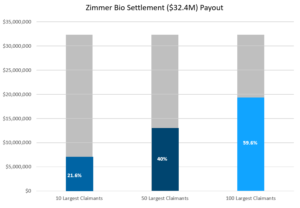What Can Investors Learn from the Zimmer Bio Settlement Administration?
On December 14, 2020, the US District Court for the Northern District of Indiana ordered the distribution of net settlement funds in the securities class action against Zimmer Biomet Holdings, Inc., a local medical device company. Claimants received payouts in February 2021. The briefing in support of final distribution offers investors insights into the administration, including the predominance of third-party filers, variations in their service quality, and their use of technology to expand participation by smaller investors who would otherwise miss out.
The Litigation and Settlement
In total, resolution took 4 years from initial complaint filing (12/2016) through final distribution order (12/2020). This is within the usual 4-6 years for duration of proceedings.
The class received $32.5M (65%) of the $50M recovery. The other $17.4M (35%) went to counsel fees (30%), and plaintiff awards, litigation expenses, and administration costs (collectively, 5%). This legal fee percentage was above average for all securities cases, but within range for smaller ones settling at or below $50M.
Three Administration Takeaways
1. Most filings were by third parties: Third-party filers were responsible for the overwhelming majority of claims submitted for institutional and retail investors. Only 3,165 claimants (5%) filed directly, by paper or through the settlement website. The other 61,330 claims (95%), were submitted electronically by institutions and third parties, e.g. banks, brokers, nominees, and others.
2. High deficiency rates: Both filer groups had high deficiency rates but surprisingly, the rate for direct filers was lower at 45.3% (1,434 claims) versus 66.5% (40,759 claims) for electronic filers. The latter deficient claims were submitted by 58 electronic filers.
3. High rejection rate: Of 64,495 claims filed, 23,139 (36%) were accepted and 41,356 (64%) were rejected. In other words, roughly two-thirds of all claims submitted were defective and ultimately rejected. According to counsel’s memorandum (at p. 4), the claims “were rejected for the following reasons: (i) 32,693 Claims had no purchase of [Zimmer Biomed] Securities during the Settlement Class Period; (ii) 5,045 Claims did not result in a Recognized Claim under the Plan of Allocation; (iii) 3,575 Claims had uncured deficiencies; (iv) 38 Claims were duplicates; and (v) 5 Claims were withdrawn.”
The high deficiency and rejection rate for electronic filers shows significant differences among third party filers in the quality of their submissions. Not all filing firms do an equal job, and vendor selection can make a significant difference in your outcomes and payouts.
Payout Analysis
The pro-rata payout rate on share losses was 5.74%, in line with the 3% to 8% average in most settlements. The bar charts below show how much of the $32.4M in net settlement funds[1] was paid to the 10 (21.6%), 50 (40%), and 100 (59.6%) largest claimants.

Most settlement dollars went to institutions: Assuming payout amounts correlate with investor size, the majority of net settlement funds ($19.4M, 59.6%) went to 100 institutions with RL exceeding $1M. This concentration is not surprising given institutions own 88% of Zimmer Biomet shares.
Smaller investors participated heavily through third party filers: Third-party filers also enabled significant participation by smaller investors. Again, assuming a correlation between investor size and loss amounts, 22,800 claimants with RL of $250K or less received $6.1M, 19% of the net settlement funds.
Conclusions
Third-party filers now dominate claims filing for all investors, big and small. In addition to filing for larger institutions, they ensure significant participation by small investors who would otherwise likely not submit claims.
Technology including the ability to file claims electronically and in bulk has ‘democratized’ settlement participation. Here, for example, the smaller investors dwarfed in number the large institutional investors. While the majority of payouts were still concentrated with the institutions – consistent with their high percentage ownership of the company – recoveries by these smaller investors still comprised, in total, a significant portion of total settlement.
The Zimmer Biomed administration also shows how much third party filers vary in the quality of their submissions. More bad claims were filed than good, and the very high deficiency and rejection rates reinforce for investors that good servicer selection can have a meaningful impact on their claim outcomes and payouts.
[1] Half of one percent (.5%) of the net settlement funds, about $163K, was used to compensate roughly $1.8M input/call option losses.
Subscribe to FRT’s Monthly Newsletter
Financial Recovery Technologies’ Shareholder Litigation Fast Five provides you with the top news in shareholder class actions. This is your exclusive summary of the latest industry developments related to settled, group and antitrust actions and recovery opportunities. Click here to subscribe.
Learn More
To learn more about how FRT can help your firm incorporate Shareholder Litigation Recovery into your ESG policy, contact us at learnmore@frtservices.com.
This communication and the content found by following any link herein are being provided to you by Financial Recovery Technologies (FRT) for informational purposes only and does not constitute advice. All material presented herein is believed to be reliable but FRT makes no representation or warranty with respect to this communication or such content and expressly disclaims any implied warranty under law. Opinions expressed in this communication may change without prior notice. Firms should always seek legal and financial advice specific to their unique situation and objectives.




